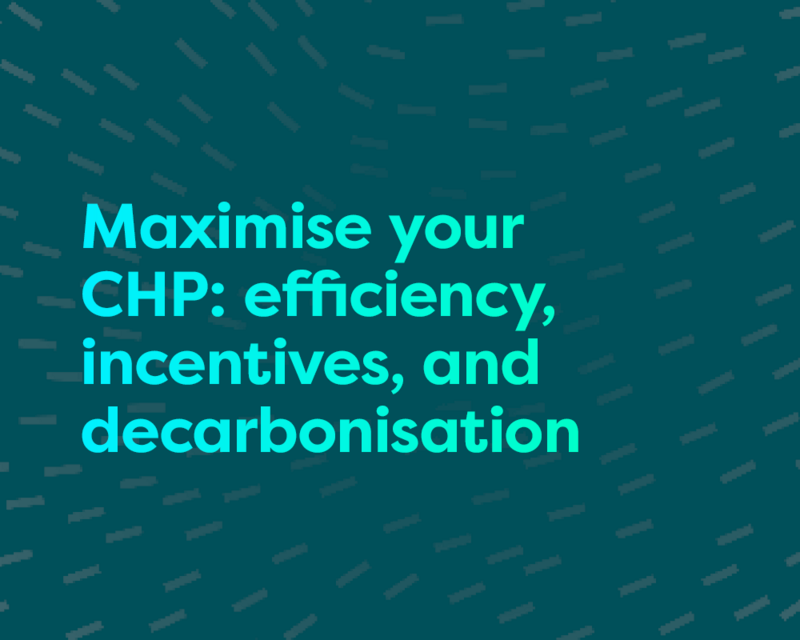Combined Heat and Power: opportunities now through CHPQA and considerations for your net zero strategy

In this article, Maiti Hutchinson and Justin Okpe, consultants who support clients in identifying utility, carbon and cost reduction opportunities, aim to discuss and answer these questions:
- Why has the perception of CHP changed?
- What enablers and barriers can CHP support to achieve ambitious carbon targets?
- How can operators maximise the benefits throughout the CHP's lifetime?
CHP schemes in a shifting Carbon landscape
CHP engines are an efficient means of combusting gas into generating both electricity and heat. In the last 20 years, many businesses have invested in CHPs with them forming a key part of their decarbonisation strategy as well as providing operational savings and higher efficiency than separate heat and power generation.
The carbon emission per kWh of grid electricity has fallen by 70% from 2010 to 2023, now falling below natural gas emission levels. This reduction in grid electricity emissions has coincided with an uptake of businesses investing in CHP installations as a generations strategy that carries a long asset life. Over the past 15 years, CHPs have transitioned from being carbon saving to carbon positive, compared to grid electricity.
To achieve net zero targets, natural gas will need to be significantly reduced, suggesting a decision point where CHPs may need to be phased out or overhauled significantly to work with low carbon fuels, which is complex and carry significant supply risks uncertainties at their stage of development. Whilst considering their future decarbonisation strategy, corporate organisations in the UK can still optimise existing schemes to make the most of the assets available.
CHPQA rewards CHP schemes that use outputs efficiently.
The UK government operate a scheme to reward companies who are using their CHPs efficiently. This is known as CHP Quality Assurance (CHPQA). The scheme incentivises good quality CHP performance with discounts on their gas bills’ Climate Change Levy (CCL) and Carbon Price Support rates (CPS). Good CHP performance is achieved through high electrical and thermal efficiency. We find that many of our clients with CHP schemes are not aware of this scheme, with CHP scheme suppliers prioritising implementation rather than the other benefits post implementation.
Many manufacturing clients also may already be in Climate Change Agreement (CCA) commitments where they already receive discounts on CCL rates; CHPQA provides levy reductions independent of the CCA. The government provides this discount on a sliding scale meaning that even if your CHP is not operating at the efficiency threshold set as ‘good performance’ there are still potential cost savings that can be achieved.
Requirements for a CHPQA application are:
Technical details of the CHP scheme
- Unit generation sizes
- Metering/monitoring arrangements
- Technical drawings of the scheme
A calendar year’s worth of energy data
- Fuel input to scheme
- Power output
- Heat output utilised by the site
This data is analysed and CHPQA bespoke efficiencies are calculated to submit to the government along with the data itself. The deadline for submission of 2025 data will be due by the end of Q1 2026.
The future of CHP in the context of Net Zero
Eventually, with the current technological, commercial and GHG reporting landscape, those operating CHP schemes with ambitious decarbonisation targets will be left with a challenging decision – to accept the large uplift in OPEX by switching to low carbon grid electricity, high CAPEX and OPEX in fuel switching to lower carbon fuels or risk not achieving Scope 1 and 2 targets while keeping utility expenditure low.
Purchasing gas with low carbon credentials is also currently facing uncertainty. At the point of writing this article, Biomethane certificates or credits cannot be used to adjust scope 1 emissions resulting from the combustion of gas delivered via a common carrier pipeline. In other words, unless there is a direct source of biomethane used in the scope, this is not recognised by current GHG protocols.
So, how do you reduce the carbon intensity of energy generated by your CHP, at least in the short term, and prepare for the transition? CHPs generate heat alongside electricity; it is important to maximise the use of this heat on site to reduce the carbon emissions per kWh with a specific focus on utilising hot water produced at low temperatures, prioritising steam for the processes that require it. This increases the efficiency of your CHP due to less heat being wasted and reduces heat demand on the site’s ancillary heat-generating equipment. With lower temperatures, this increases the attractiveness of incorporating alternative low carbon technologies such as heat pumps and heat recovery as more viable solutions.
A more efficient system then increases the likelihood of yielding cost benefits via CHPQA, which could be used to help fund the investment in integrating lower temperature heat ready for lower carbon technologies.
How we help
Verco has expertise in preparing CHPQA applications and supporting sites through audits of their submissions from CHPQA. We understand the nuances of how the schemes may be utilised at sites so are well placed to support you in your CHPQA submission. Our heat mapping expertise can also help you with increasing your CHP efficiency score through improved heat use, further unlocking short-term cost savings and enabling greater decarbonisation goals to be met.
Verco can also support in developing feasibility studies and transition strategies away from CHP schemes to low carbon technologies, which also includes funding applications to reduce the capital costs associated with transitioning.

